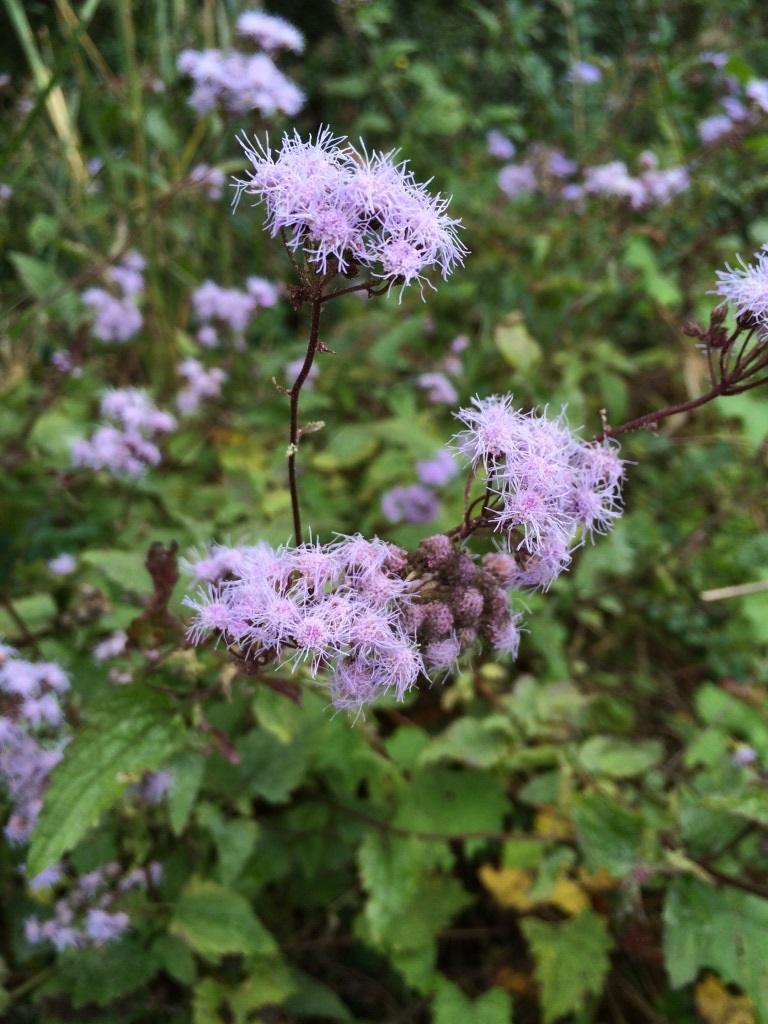
by Mary Salinas | Nov 18, 2014
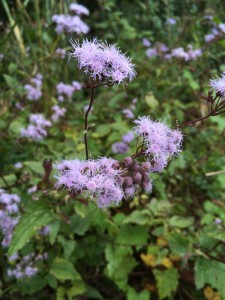
Blue Mistflower – Image Credit Mary Derrick, UF / IFAS
Here’s a beautiful native perennial wildflower that is easy to grow and generally available in the independent nursery trade. In the wild, you can encounter them at the edges of woodlands and ponds as they prefer moist areas. Blue mistflower, Conoclinium coelestinum, performs well as a perennial in the home landscape but does spread easily by seed and will spread in the garden. It also spreads through underground rhizomes which allow it to form large clumps. This is an advantage for the informal garden, however, the gardener who prefers a more formal look will have a bit more maintenance in controlling that spread.
The abundant flowers look like bluish-purple puffballs on the top of the stems. The color is unusual and adds a striking touch in the garden. The bloom season is mid-summer to mid-fall. Butterflies are frequent visitors, making this an excellent addition to your butterfly garden.
Blue mistflower has a full rounded form and will grow to 3 feet under optimum conditions. Leaves are opposite and have a triangular shape. Growth and blooming is best in full sun to part sun conditions.
Give it a try!
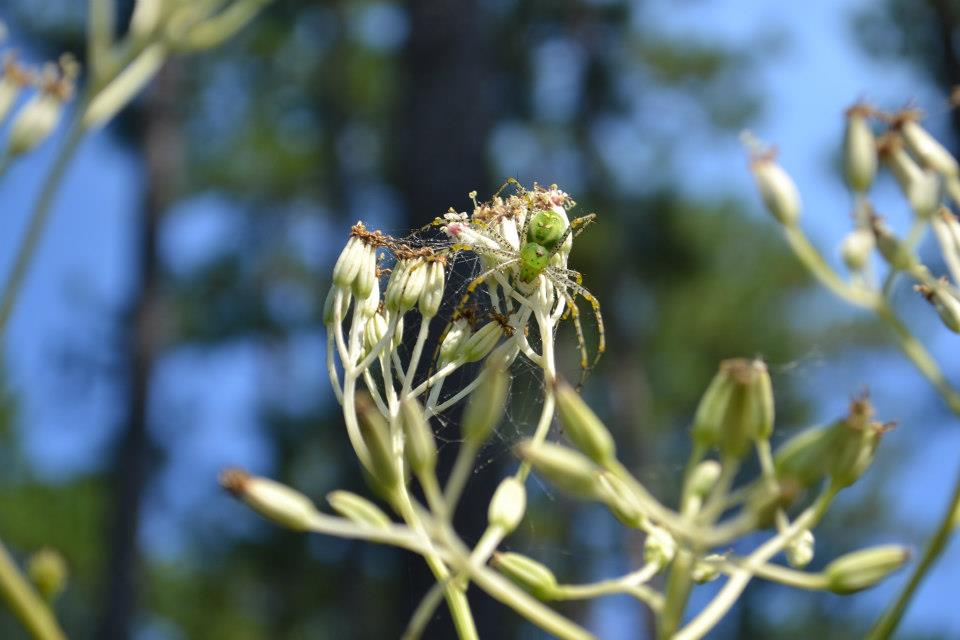
by Beth Bolles | Nov 4, 2014
Take a walk through the garden or woods this fall and you are sure to pass by a Green lynx spider. Unless you are very observant though, you will probably not realize that this common spider is perched upon flowers and low shrubs, ready to catch an insect meal.
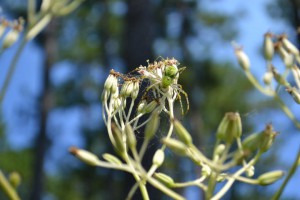
An adult spider blends in well with plants. Photo by Beth Bolles, Escambia County Extension
Even though Green lynx spiders are very large, they are often well camouflaged in plant material. Spiders are bright green with a lighter color on the abdomen including some small red markings. The legs have distinctive black spines.
This spider does not spin a web but actively hunts insects using a dragline as it quickly moves or jumps over plants. It is an opportunistic feeder catching many types of insects that are visiting flowers. It has been noted as an important predator of some crop damaging insects.
Females will normally lay one egg sac in the fall and guard it from predators. It is constructed in the upper portions of branches and has webbing connecting it to nearby plant leaves. This webbing becomes a protective area for the emerged spiderlings until they are able to take care of themselves.
Lynx spiders pose no harm to people and should be considered one of many beneficial arthropods that we see in Florida.
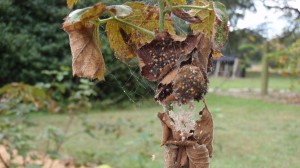
Young spiderlings on a blackberry guarded by the adult. Photo by Beth Bolles, Escambia Extension
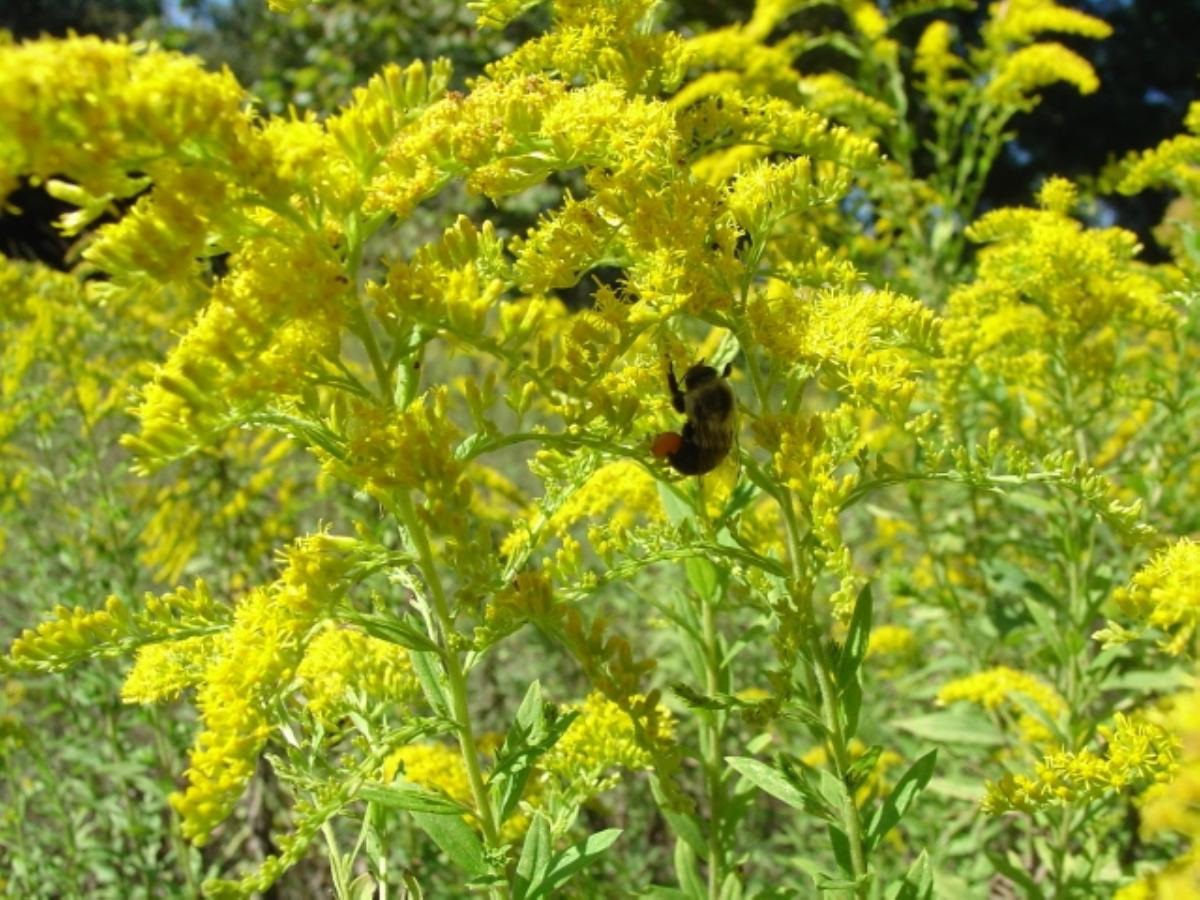
by Larry Williams | Oct 14, 2014
Goldenrod are easily recognizable this time of year with its showy yellow flowers held high on stems moving back and forth by autumn winds. A field full of these vivid yellow blossoms is a sight to see with a bright blue fall sky as a background. But too often this plant is blamed for the sneezing, runny nose and itchy eyes that many people suffer while goldenrod is blooming.
The common culprit causing these allergy symptoms is ragweed, not goldenrod.
Ragweed blooms at the same time as goldenrod, August to frost.
Ragweed releases its billions of tiny, lightweight pollen grains into the air this time of year. This windborne pollen causes much of the hay fever problems. Goldenrod pollen is too large and heavy and sticky to be windborne. It relies on insects to carry its pollen. I suppose if you put your nose right up into a cluster of goldenrod flowers and took a big sniff, you might be bothered by the pollen. But otherwise, it is not going to get into your nose.
Goldenrod is an innocent bystander as ragweed remains camouflaged releasing its pollen. Ragweed visually blends in with other green plants. Despite the fact that common ragweed, an annual, can grow three to greater than six feet in height, it just does not get your attention. It is quite common along roadsides, vacant lots and abandoned fields. Its inconspicuous flowers start out as green, similar in color to the leaves, turn a yellowish-green and finally dry to a brown color. They are never showy.
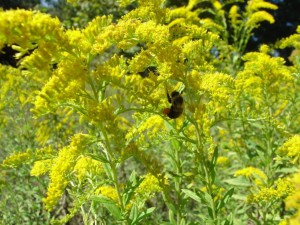
Goldenrod in bloom Photo credit: Larry Williams
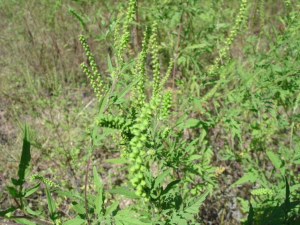
Ragweed in bloom Photo Credit: Larry Williams
Enjoy the bright yellow flowers of goldenrod this fall. But please do not blame them for your allergies.
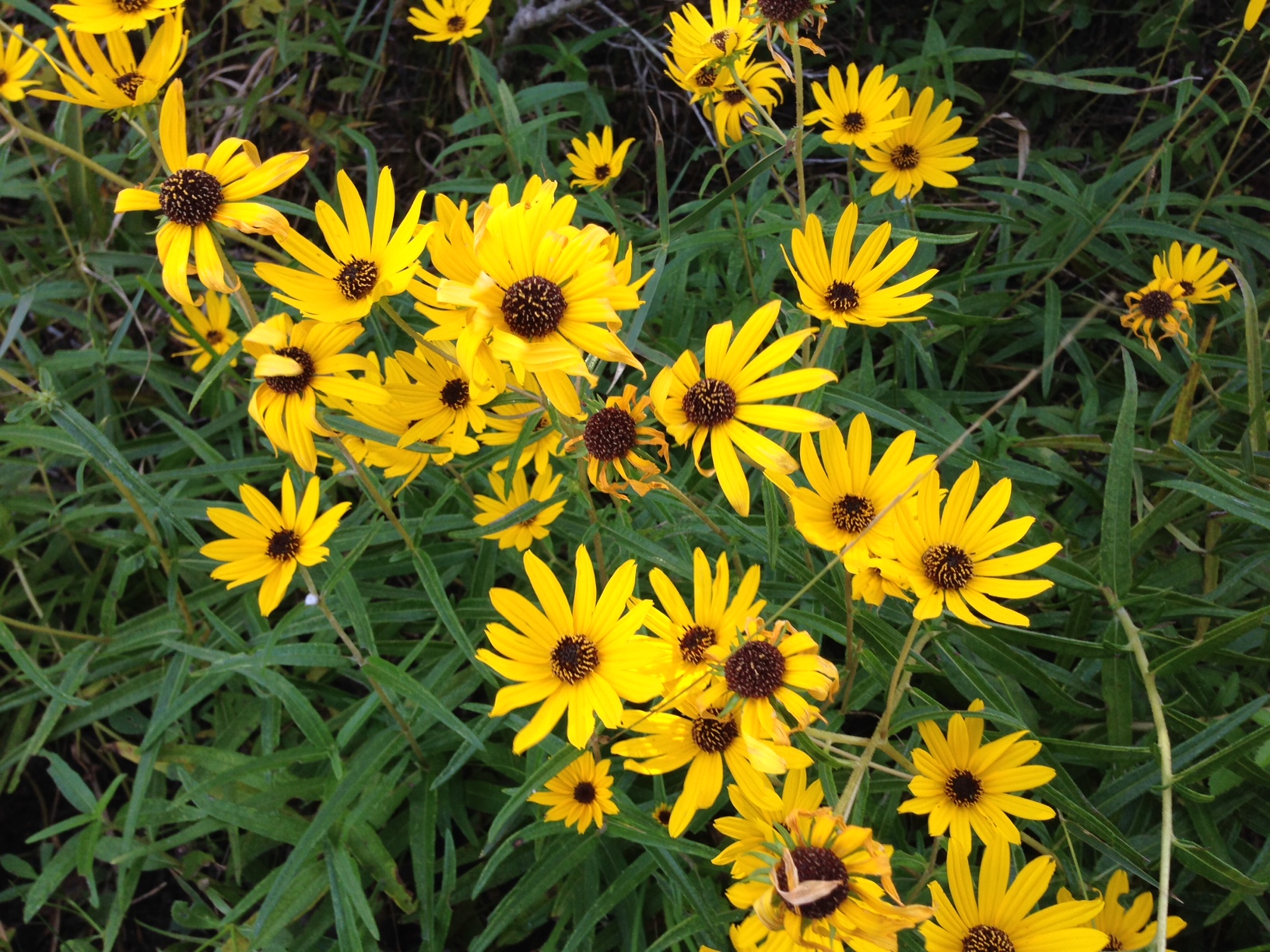
by Mary Salinas | Sep 23, 2014
In the midst of your September strolls through natural Florida, you may come across this native beauty, the narrowleaf sunflower, Helianthus angustifolius. Another common name is swamp sunflower. I found this gorgeous patch in the photo close to the shore of Apalachicola Bay. It occurs throughout Florida and north throughout much of the eastern United States. Florida is fortunate to be home to over 20 native species of sunflower.
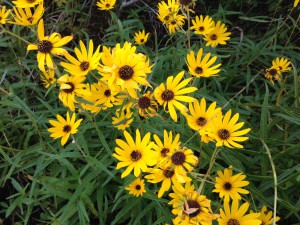
Narrowleaf Sunflower. Photo credit: Mary Derrick, UF/IFAS Extension.
This perennial starts blooming in late summer and dazzles admirers throughout autumn. The 2 to 3 inch flowers with bright yellow petals and brown centers are attractive to butterflies and other pollinators. What a great addition to your butterfly garden!
Plants generally grow to about 2 foot tall but they can grow a bit leggy to 6 foot. If desired, keep them more compact through pruning in late spring. Clumps can be divided every few years to spread them out or to share with friends and neighbors.
Like all sunflowers, it loves full sun but can tolerate some light shade. Narrowleaf sunflower is salt and flood tolerant and will do well in most soil types, however it does best in consistently moist conditions.
Narrowleaf sunflower plants may be difficult to find in the nursery trade but they can be readily started from seed.
For more information and seed sources:
Florida Wildflower Foundation
Atlas of Florida Vascular Plants: Helianthus species
Common Native Wildflowers of North Florida
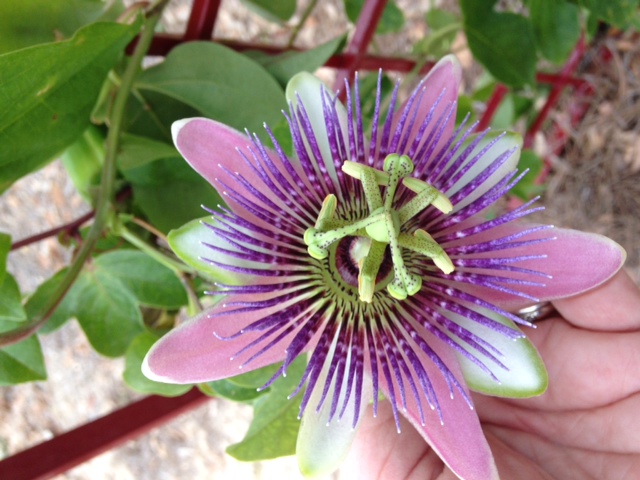
by Julie McConnell | Sep 2, 2014
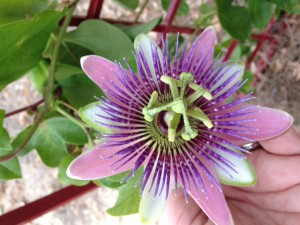
Purple passionflower
Gulf Fritillary caterpillars have a voracious appetite for purple passionflower vine Passiflora incarnata! This native vine is a host for the Gulf Fritillary Butterfly Agraulis vanilla larvae, is easy to grow, and readily available in garden centers.
Like any other vine, it grows quickly and may spread across your garden, so keep this in mind when choosing a location. It prefers full sun, is drought tolerant, adapts to many soil types, and should be given support for twining tendrils. Purple passionflower has intricate purple flowers that are followed by the fruit called a maypop, which is another common name for this vine.
Gulf fritillary butterflies are primarily orange with some black and white markings. They prefer sunny areas and adults will feed on nectar from many different flowering plants. However, they are more specific about where they will lay eggs because the diet of the caterpillar is more selective than adults.
If you have purple passionflower in your landscape, look for tiny yellow eggs and orange caterpillars with black spikes to see if you have a backyard Gulf fritillary nursery. Plants may be totally defoliated by the hungry caterpillars, but healthy plants can tolerate the damage and should flush back out without difficulty.
by Taylor Vandiver | Jul 1, 2014
The summertime often reminds us of our uninhibited spirit. With Independence Day not far off, Floridians will be celebrating the freedom of our nation while battling the oppressive climate you can’t seem to escape this time of year. As we approach the apex of heat and humidity here in Florida, we would do well to remember the tenacity of our native wildflowers and their “spirited” survival of Florida’s extreme conditions.
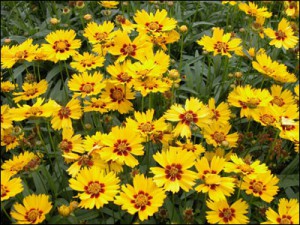
Coreopsis flowers. Photo courtesy UF/IFAS.
Historically, Florida’s landscape was alive with color throughout the seasons. Through urbanization and cultivation we’ve lost a large part of that legacy; however, we can reestablish some of Florida’s colorful past in our own yards and neighborhoods.
In order to ensure successful planting of wildflowers it is important to properly select and prepare your site. You will want to choose a sunny-well drained area and cut any existing vegetation to the ground. It may be beneficial to put down sheets of cardboard to smother what’s left of the vegetation. This is best done in the summer in advance of fall planting.
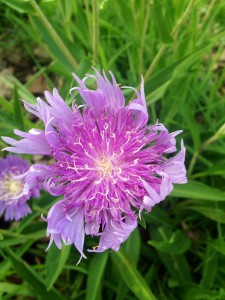
Stokes’ Aster in bloom.
Planting is best done late August to early September in North Florida. Soil-to-seed contact is critical so 1 day before seeding, or just prior to seeding, firmer soils need to be lightly scratched with a rake. Sandy soils might have to be made more firm to ensure that seed do not sink too deep. Broadcast the wildflower seeds at the recommended rate then press them into the soil by walking around on the planting site.
Wildflower seeds require adequate moisture during germination. After planting irrigate the site with about 1/4 to 1/2 inch of water daily for the first few weeks. After that, irrigate with about 1/2 inch water only if the wildflowers show signs of drought stress. Once established though, the meadow needs very little, if any, irrigation. Fertilizers should be avoided altogether as they promote the growth of aggressive weeds. Many of Florida’s native wildflower species are adapted to and perform well in soils with low fertility. Your wildflowers will re-send themselves if given the opportunity so wait until seed have matured before deadheading or mowing. Cut no lower than six to eight inches to avoid damaging the crowns of grasses and wildflowers.
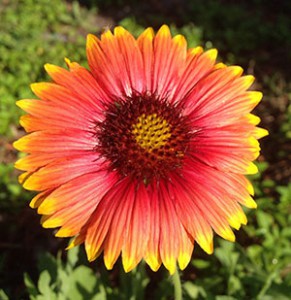
Native Gaillardia. Photo courtesy UF/IFAS.
To successfully cultivate a wildflower meadow in your home landscape, it’s helpful to select plants with the qualities to fit the conditions at your site. Also, consider blooming dates of flowers in order to provide color and interest for your landscape spring through fall. While not always possible, it’s best to purchase seeds and plants known to be Florida ecotypes. Consult with local nurseries and garden centers for more information on plant and seed availability and seeding rates. You can always contact your local Extension Office for more information. Other good sources of information are the Wildflower Seed And Plant Growers Association, Inc. (www.floridawildflowers.com); Association of Florida Native Nurseries (www.afnn.org); and the Florida Wildflower Foundation (www.floridawildflowerfoundation.org).
Growing wildflowers can restore a special sense of natural history close to home. So if you are looking for an “explosion” of color that will stand the test of time, Florida’s native wildflowers will not disappoint.















